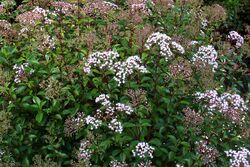Biology:Ageratina ligustrina
| Ageratina ligustrina | |
|---|---|

| |
| Scientific classification | |
| Kingdom: | Plantae |
| Clade: | Tracheophytes |
| Clade: | Angiosperms |
| Clade: | Eudicots |
| Clade: | Asterids |
| Order: | Asterales |
| Family: | Asteraceae |
| Genus: | Ageratina |
| Species: | A. ligustrina
|
| Binomial name | |
| Ageratina ligustrina | |
| Synonyms[1] | |
|
Synonymy
| |
Ageratina ligustrina, the privet-leaved ageratina or privet-leaved snakeroot, is Mesoamerican species of evergreen flowering shrub in the sunflower family. It is widespread across much of Mexico and Central America from Tamaulipas to Costa Rica.[2][3][4]
Ageratina ligustrina grows to 4 metres tall, producing flat heads of daisy-like white to pink composite flower-heads in autumn.[5] The fragrant flower-heads may be up to 20 centimeters in diameter and attract butterflies.[6] The leaves are light green, elliptic to lance shaped, with toothed margins.[7]
Cultivation
Ageratina ligustrina has been in cultivation since the mid 1800s, and in 1996, it gained the Royal Horticultural Society's Award of Garden Merit.[8][9] It is not fully hardy in temperate regions.[5] In the United States , it is suitable to be grown outdoors in hardiness zones 9–11.[7] A. ligustrina tends to be susceptible to slugs and aphids if grown outside, and whiteflies and red spider mites if grown in a greenhouse.[10]
Etymology
Ageratina is derived from Greek meaning 'un-aging', in reference to the flowers keeping their color for a long time. This name was used by Dioscorides for a number of different plants.[11]
The Latin specific epithet ligustrina highlights the plant's resemblance to the privet Ligustrum, though the two plants are not believed to be closely related.[12]
Chemical compounds
Eupalin and eupatolin are flavonol rhamnosides isolated from E. ligustrinum.[13]
References
- ↑ "Ageratina ligustrina (DC.) R.M.King & H.Rob.". The Global Compositae Checklist (GCC). http://www.theplantlist.org/tpl1.1/record/gcc-24178.
- ↑ Turner, B. L. 1997. The Comps of Mexico: A systematic account of the family Asteraceae, vol. 1 -- Eupatorieae. Phytologia Memoirs 11: i–iv, 1–272
- ↑ Linares, J. L. 2003 [2005]. Listado comentado de los árboles nativos y cultivados en la república de El Salvador. Ceiba 44(2): 105–268.
- ↑ Berendsohn, W.G., A. K. Gruber & J. A. Monterrosa Salomón. 2009. Nova silva cuscatlanica. Árboles nativos e introducidos de El Salvador. Parte 1: Angiospermae - Familias A a L. Englera 29(1): 1–438.
- ↑ 5.0 5.1 RHS A-Z encyclopedia of garden plants. United Kingdom: Dorling Kindersley. 2008. pp. 1136. ISBN 978-1405332965.
- ↑ "Ageratina ligustrina | Coastal Hedging". https://www.coastalhedging.co.uk/shop/evergreen-hedging-shrubs/ageratina-ligustrina.
- ↑ 7.0 7.1 Shoot. "Ageratina ligustrina Eupatorium ligustrinum Eupatorium micranthum Eupatorium weinmannianum Privet-leaved eupatorium Care Plant Varieties & Pruning Advice" (in en). http://www.shootgardening.co.uk/plant/ageratina-ligustrina.
- ↑ Hind, Nicholas (2006). "567. AGERATINA LIGUSTRINA: Compositae". Curtis's Botanical Magazine 23 (4): 278–288. ISSN 1355-4905. https://www.jstor.org/stable/45066102.
- ↑ "RHS Plant Selector - Ageratina ligustrina". http://apps.rhs.org.uk/plantselector/plant?plantid=5592.
- ↑ "Eupatorium Ligustrinum from Burncoose Nurseries". https://www.burncoose.co.uk/site/plants.cfm?pl_id=1835.
- ↑ Gledhill, David (2008). "The Names of Plants". Cambridge University Press. ISBN:9780521866453 (hardback), ISBN:9780521685535 (paperback). pp 39
- ↑ Harrison, Lorraine (2012). RHS Latin for gardeners. United Kingdom: Mitchell Beazley. pp. 224. ISBN 9781845337315.
- ↑ The structures of eupalin and eupatolin. Two new flavonol rhamnosides isolated from Eupatorium ligustrinum D.C. L. Quijano, F. Malanco and Tirso Ríos, Tetrahedron, Volume 26, Issue 12, 1970, pages 2851-2859, doi:10.1016/S0040-4020(01)92863-7
External links
Wikidata ☰ Q4692127 entry
 |

